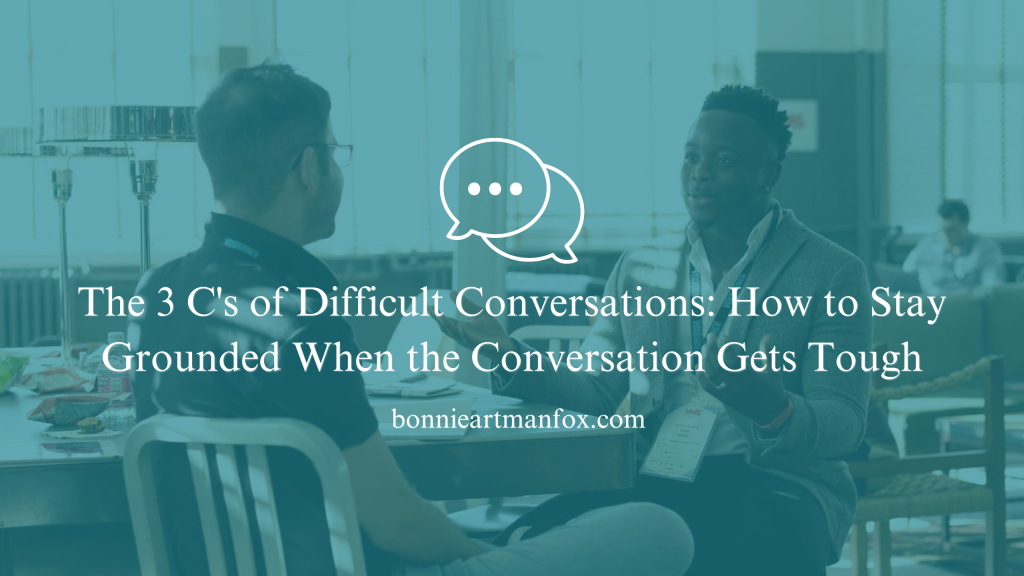
The 3 C’s of Difficult Conversations: How to Stay Grounded When the Conversation Gets Tough
As a leader, Ben knew he needed to address Bob’s abrasive behavior. Bob had a pattern of dismissing colleagues’ ideas in meetings, sending curt emails that left people feeling belittled, and making sarcastic comments that created tension across the team.
Ben found every reason to avoid the conversation. He anticipated Bob being defensive. He worried about saying the wrong thing. He told himself it wasn’t that bad, maybe Bob would improve on his own.
Perhaps you have a “Bob” in your work setting, someone whose behavior is damaging team morale, but the thought of addressing it makes your stomach turn.
Most leaders avoid these conversations because they’re hard. They’re uncomfortable. And there’s a real fear that the conversation will go sideways.
One thing I’ve learned after 25+ years of helping leaders navigate workplace conflict: Your mindset going into the conversation matters as much as the words you say.
The 3 C’s: Your Mental Framework for Difficult Conversations
When you’re about to have a difficult conversation, prepare yourself by embodying these three qualities:
1. Calm
Set the intention to approach the conversation prepared, focused, and grounded in your company’s core values and your role as a leader.
Why this matters: When you’re calm, your brain is in a state that allows for clear thinking and thoughtful responses. When you’re anxious or agitated, your amygdala (the brain’s alarm system) takes over, making it harder to listen, think clearly, and respond effectively.
What this looks like in practice:
- Take a few deep breaths before the conversation
- Remind yourself of your purpose: staff development and culture protection
- Ground yourself in facts, not assumptions or emotions
- Enter the conversation as a leader who cares about helping this person succeed
The impact: When Bob senses you’re calm and clear-minded, his brain is more likely to stay receptive rather than defensive. Your composure helps regulate his nervous system.
2. Composed
Composed means maintaining self-control and poise, even when the conversation doesn’t go the way you hoped.
Why this matters: Bob may try to blame others, deflect responsibility, or become defensive. If you react emotionally or get pulled off track, you lose your leadership presence and the conversation derails.
What this looks like in practice:
- Stay levelheaded even if Bob says something that frustrates you
- Listen beyond his words to understand what’s really going on
- Keep the conversation focused on his behavior and its impact—not on others
- Don’t take his defensiveness personally; it’s a common reaction when people feel threatened
The impact: Your composure keeps the conversation on track and demonstrates that you’re not here to attack, you’re here to address specific behaviors that need to change.
3. Civil
Civility means remaining polite and courteous, even if Bob is disrespectful or you personally don’t like him.
Why this matters: As one human being to another, civility conveys respect and regard. Even when addressing unacceptable behavior, you can do so with dignity.
What this looks like in practice:
- Use a respectful tone, even if Bob doesn’t reciprocate
- Avoid sarcasm, eye-rolling, or dismissive body language
- Acknowledge his perspective, even if you don’t agree with it
- Separate the person from the behavior: you’re addressing actions, not attacking character
The impact: Civility creates psychological safety. When Bob feels respected (even in a tough conversation), his brain is less likely to perceive you as a threat, making him more open to hearing your feedback.
The Neuroscience Behind the 3 C’s
When Bob perceives you as calm, composed, and civil, his brain interprets the interaction as safe. This keeps his prefrontal cortex (the thinking brain) engaged, allowing him to listen, reflect, and potentially take responsibility.
When you show up anxious, frustrated, or hostile, Bob’s amygdala signals danger. His brain goes into fight, flight, or freeze mode. In this state, he can’t think clearly, take in feedback, or respond productively. All he’s trying to do is protect himself.
Your mindset literally shapes his brain’s ability to receive what you’re saying.
Taking Responsibility for Your Part
While being calm, composed, and civil should be part of every human encounter, it’s especially difficult when the other person is disrespectful and doesn’t take responsibility for their actions.
This is when it’s crucial to remember: You are not responsible for Bob’s actions, only your own.
The Leadership Decision
Having difficult conversations is one of the hardest parts of leadership. But avoiding them is harder, on you, on your team, and on your culture.
When you approach these conversations calm, composed, and civil, you increase the likelihood of a positive outcome. You demonstrate leadership. You protect your culture. And you give the other person the best possible chance to hear you and make a change.
Your mindset matters. Your preparation matters. Your follow-through matters.
Ready to stop avoiding and start leading? Get the strategy and support you need to have that difficult conversation with confidence:
Learn about Difficult Conversations Strategy Coaching
Make the conscious choice to address challenging conversations calm, composed, and civil, and increase the likelihood of a positive outcome.
About the author

Bonnie Artman Fox, MS, LMFT works with executive leaders who want to gain self-awareness about the impact of their words and actions and up-level their interpersonal skills.
Drawing from decades as a psychiatric nurse and licensed family therapist, Bonnie brings a unique perspective to equip executive leaders with the roadmap to emotional intelligence that brings teams together.
Bonnie’s leadership Turnaround coaching program has an 82% success rate in guiding leaders to replace abrasive behavior with tact, empathy, and consideration of others. The end result is a happy, healthy, and profitable workplace…sooner vs. later.
